Everything my younger daughter needed to know about advertising, she learned by buying Sea Monkeys with her allowance a few years ago. The ad pitch (which hasn’t changed since the version they ran in comic books when I was a kid) promises this whole world of smiling cartoon creatures and then the actual product is a dried pouch of brine shrimp.
A lot of what marketers are trained to do is weave together an amazing story about something as mundane as a dried pouch of brine shrimp.
Over time, we grow to expect marketing to over-promise and under-deliver. Kids develop BS detectors early. Younger generations are particularly desensitized to marketing pitches.
Honesty is in such short supply in advertising that it can be arresting when the advertising story matches the actual product experience. Apple’s “Shot on iPhone 6” campaign is particularly impactful (although even that didn’t stop some pranksters in San Francisco from posting parody ads featuring all of the bad selfies “also” taken with iPhone 6).
Contrast Apple’s “Shot of iPhone 6” campaign with Nokia’s Lumia 920 promotion video a couple years ago, where they eventually had to apologize for faking the footage with professional equipment.
I like this Seth Godin riff on this mismatch between marketing expectations and product reality:
“Marketing pitches are finely tuned to resonate with the audience in mind. Too often, though, the marketer is only in charge of the pitch, and someone else in the organization has to make the thing.
“So the marketer brags about how tasty the food on the airplane is, or how reliable the cell phone service is or how magically transporting the aromatherapy of the soap is–and then someone else, someone under different pressures and constraints–has to deliver. And they rarely do…
“Marketers need to spend less time making promises and more time keeping them.“
(Marketoonist Monday: I’m giving away a signed cartoon print. Just share an insightful comment to this week’s post by 5:00 PST on Monday. Thanks!)
Here’s a cartoon I drew on this topic a few years ago:
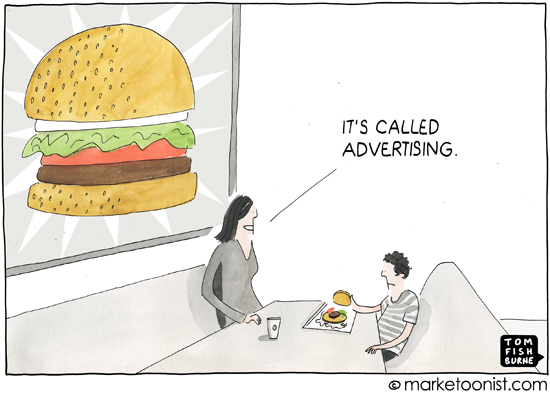
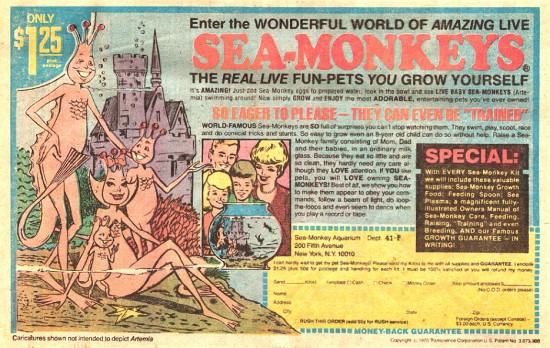

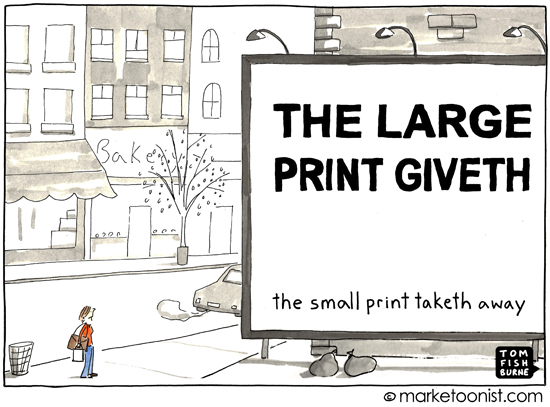
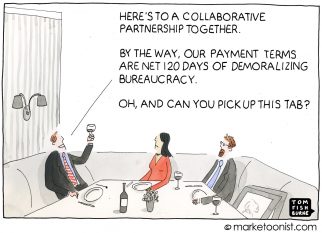
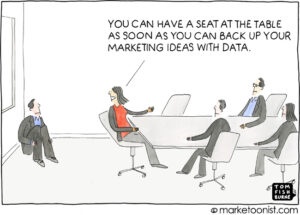
BC says
Never confuse selling with delivery…
Christian says
Another great article! Keep up the work, I love it! Somehow surprising to myself is that it’s the only newsletter I really wait for and open weekly…
Judy A says
I love the large/small print cartoon. Nailed it.
Henry says
I think this is one reason why big companies fail to compete with smaller, more agile and just plain honest newer companies, where marketing and the product are one and the same.
Somewhat ironically, we’ve been using the half-and-half burger shot from the McDonald’s ‘Behind the scenes’ commercial to illustrate this expectation gap in presentations – ironic in that it’s one of the biggest & most advertised brands on the planet that calls this out:
Dawn Campbell Giesman says
I enjoy your Marketoons very much! This one is timely and relevant as I had this conversation with my fifth grader this past weekend, just after we opened our drive thru lunch order. Keep up the entertaining and intellectually-provocative work!
Ced says
The gap between what you see in an ad and what you get when you consume the product/service that was advertised can be puzzling.
It’s a pity when marketing is used to cheat consumers. It is harmful to both brands and marketing pros.
Best marketing possible lies in the product and the associated experience.
Ori Pomerantz says
This may be bad for advertising, but I really like that the younger generation is developing mental antibodies. There is no way to avoid having people lie to them, so they should defend themselves.
Stacy says
Delivering on the promise in large, tiered orgs takes a lot more effort; but it’s worth it. In higher ed, future students practically have to have a degree in order to apply, find funding and enroll in classes that will eventually lead them to a degree. One bad run-in with an instructor, campus security, dining room attendant, Bursar’s office, etc can damage the multi-year experience. Institutions facing more competition can’t rely on that same multi-year relationship to keep the students from going elsewhere.
Deb says
In my industry, the specialty food trade, we have the opposite problem. Most producers over-engineer the product to outstanding quality standards, but cheap out on hiring the right talent to brand and market the product. hence, the consumer doesn’t know what’s in the product and sales never take off.
Phil Jones says
Makes me think of Marmite…
Judith Hutchinson says
It’s true – good advertising gives marketers a bad name. Honest marketing gives marketers a good name – as well as repeat business!
Surekha says
Which is why the companies that truly succeed in keeping their promises are those that are values led, and understand at every step of the process that things they say and how they deliver produce expectations and they only have one chance to make the impression they must make to create a repeat customer and convert them to advocates! Where there is this understanding, the intention is set right for all aspects of the seven Ps, everyone wins!
jhsu says
I’d like to quote Bill Bernbach to echo Tom’s post:
“Advertising doesn’t create a product advantage. It can only convey it.”
“A great ad campaign will make a bad product fail faster. It will get more people to know it’s bad.”
“The most powerful element in advertising is the truth.”
“Word of mouth is the best medium of all.”
Isn’t branding about trust?
Larry Burns says
Have not commented in too long but, always enjoy the ‘toons as well as the commentary. Recall my bias is the CPG world so that colors my thoughts.
This one really lands square in the middle of the problem that persists in the world of marketing. We still think of ads as being delivered AT or TO “consumers”. The older I get the more I detest the term “consumers” and in today’s ever more transparent world our reality is the people at the end of the “purchase pretzel” (or whatever we choose to call the “path” to actually buying something) really are hip to our tricks and expect more to earn our business.
We all know advertising is designed to show things in their ‘best light’ (well, except political ads but THAT is an entirely different rant) and we really do ‘get it’. Yet when the ‘concept’ presented is so far removed from the reality of how people experience, well that disconnect is now no longer simply personal – it is also social, the butt of jokes and scorn, as well as a slow and predictable decline in brand value. The people ‘consuming’ the messaging reject its premise and hence are less likely to consume the products as intended.
Unfortunately endless repetition in this cacophony of messaging still does influence choice at the shelf – so huge budget campaigns to keep a brand ‘top of mind’ will remain with us and awareness is obviously a very powerful and important initial step to the buy. However, in my feeble mind there is also a direct connection between how many times we are reminded about the false notes of advertising and our entire outlook on believing anything. Even in 2015 it seems that the more one repeats a lie, with proper media weight, the more it attains a patina of truth and hence snake oil peddlers of whatever scope are an inescapable part of our culture and always have been.
Legitimate marketers seeking to offer real solutions to humans really do need to stay intensely aware of perception versus reality because “lipstick on a pig” really is just sad in this day and age – and nearly everyone willing to exercise their brain and be skeptical sees right through it.
Barbara Moroch says
This is not just a b-to-c issue, but a b-to-b issue as well. Truth in advertising is particularly challenging in the publishing industry, where today’s daily/Sunday readership numbers were circulation numbers a couple of decades ago. So the big ethical challenge for newspapers in particular: How to be truthful in promoting the product despite the numbers — and position it as a must-buy media option for certain advertisers?
Oun says
I’m not in advertising and I really do not comment.. but I like this blog.
Tom’s comment reminds me of my 5th grader who told me the many tricks that TV uses to advertise food: the colouring on the McD burgers, the hair spray to make XXX look like something else, the way bubbles are created in the OJ… she’s knows it all… and happily is not a sucker for the TV adds.
I really wonder why bad/false advertising keeps being successful? I don’t think it’s true that it doesn’t work… if it doesn’t why do we still have it?
I’d like Tom to answer that in one of the upcoming cartoons! Keep up the good work
Jennifer says
I agree that honesty in marketing is critical but I also believe that an organization has to put as much energy into creating a good, if not great, product to market. Too often, a poor product is developed and marketing is expected to make it sell with an “out-of-the-box campaign”. How about both departments work together to deliver a quality product that honest marketing can support?
Sean Regan says
Great article! This is why consumer reviews are so powerful – and so utilized. A prospective buyer can quickly scan the experience of hundred or thousands of actual users and see if reality meets advertising. While “truth in advertising” should always be a concern, the next frontier lies in retaining the “purity” of reviews and ensuring advertisers don’t have the ability to doctor them (or are punished for trying to do so as a disincentive). Forums for reviews will continue to expand; the trustworthiness of their content is what’s essential.
Rachel Cooper says
Much to my disappointment, my parents never fell for the whole Sea Monkey thing. It was with much excitement and anticipation that my son and I opened his present of “Aquadragons” at Christmas. I work in marketing and I have worked in film production. Despite that….oh the disappointment!
Even as marketing-savvy adults we still hope that the vision promised by advertising is at least partly true.
Tony Jacob says
Somewhere along the line many marketers and companies get confused between the ‘brand promise’ that exists in consumers’ heads and the ‘brand dream’ that only exists in their own.
Jason Cross says
Sean > and it’s why the snake oil peddlars have also created an industry around fake reviews and sites that promote them should be doing all they can to police them properly (or at least better): https://econsultancy.com/blog/66332-does-amazon-finally-care-about-fake-reviews/
Michael Rowan says
As Art and Music were removed from public education, we send our kids to private tutors and camps to provide the opportunity to youth to be exposed to such things.
As Home Economics and Life Skills were removed from public education, we send our kids online to chat and play games.
Perhaps the creation of the “sucker” is the fault of parents not filling the void – every child should help to run the household beyond cleaning their room – we may wind up with young adults that know about budgeting, credit, and how to make a wise purchasing decision.